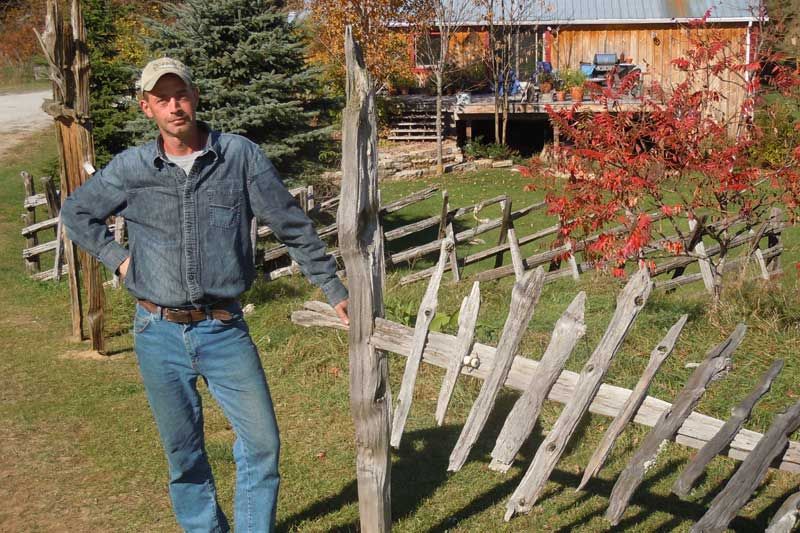Oct 17, 2013
Traditional rail fence building has long been considered a dying art but those who visited Susie Osler's studio on the Perth Autumn Studio Tour this past weekend found that one Smiths Falls resident is doing his job in keeping the tradition alive. Scott Dobson has been building traditional old-style fencing for 15 years. He grew up on a farm in Smiths Falls and first began building fences as a teenager. “Our neighbor Bus Craig needed help repairing our farm fences and needed a laborer to help. I was picked and so ended up learning a few tricks of the trade from him, but also found out that I was pretty good at it.”
Dobson worked at numerous jobs between that time and now but eventually came back to fence building, something that suits his many loves, namely working creatively with his hands in the great outdoors, plus a keen fascination with antiques and local history. “Thankfully for me, there is still a demand for the old traditional style of fencing where you do not have to dig holes into the ground due to the rocky landscape in the area,” Scott said when I interviewed him at Susie Osler’s. On site was one of Dobson’s creations, a long, free-standing Indian-style fence that Osler commissioned for a section of her property. The fence exudes a powerful grace in its long, shapely lean and the economy of materials with which it was constructed. Its main rails spring up from the ground on the diagonal and rest on V-shaped cross sections.
Dobson not only loves the actual hands-on craftsmanship involved in building fences, and the sourcing out of materials, but also delving into the history of local fence building traditions in the area. Included in his display was a collection of small models of the numerous historical styles of fencing in the Lanark area, which came to him via Alex Bowes, another lover of traditional fencing. The collection shows fences through the ages, the earliest from the mid 18th century when settlers were first clearing their 100-acre plots of land and used uprooted tree stumps and stone for their fences. Later in the 1800s, cedar became the chosen material because it was plentiful and bug resistant, and various styles evolved over the decades. The zigzag fence, block and snake fences were all examples of early cedar designs that required a substantial amount of lumber to create. The styles continued to evolve as builders looked for ways to use less material and also to avoid paying the permit fees demanded by the designers of the earlier patented models. So the John Closs fence, which was invented in Lanark and patented in the 1890s, would later, with a slight variation, become the Batton Fence invented in Clayton around the same time period. Over 12 types of similar styles would evolve in Lanark County alone, including the Indian fence, which is designed specifically to contain sheep by utilizing a diagonal configuration that confuses the sheep, thus making it difficult for them to penetrate. Similarly the goat fence was designed so that its interior side tilts inward, making it impossible for them to climb.
Aside from traditional fencing, Dobson also makes sculptural one-of-a-kind pieces, more whimsical outdoor ornaments all built from salvaged materials - mostly pieces of wood but also other old relics that Dobson is forever collecting in his travels. This tendency of his, he said, was likely inspired by his parents, both of whom were antique dealers. “I have a real strong sense of history and materials and that is where a lot of this kind of work comes from.” One example is a large swinging gate door made from a pair of huge old wooden shutters that Dobson mounted on posts; another is a long spine-like construction made from numerous pieces of wood circling a central horizontal post, creating a form that brings to mind both the skeletal remains of a huge serpent and a double helix.
Dobson said his typical customers are approximately a "50/50 split between property owners and farmers wanting to define their property lines in keeping with old traditional style fencing, and creative backyard gardeners who are looking for aesthetically pleasing structures to either enclose, decorate or grow their gardens upon.”
Scott Dobson is currently creating a website and also shows his work regularly at the annual Kiwi Gardens “Art in the Garden” show in Perth on Father's Day Weekend. For more information, contact him at 613-284-2171.
More Stories
- Latest CUPW Job Action Stops Postal Delivery Of The Frontenac News Forcing Alternate Plans
- Opponents of Barbers Lake Gravel Pit Pack Ag Hall in McDonalds Corners
- Bobsleigh Olympian Jay Dearborn At Mikes Pizza In Sydenham
- The Loins Club Of and O'Lakes Roar
- North Frontenac Back Roads Studio Tour - September 27 and 28
- Sunday Market Vendors Give Back
- George Street Work As Town Hall Renovation Nears Completion
- One Way Street Plan Hits A Dead End - Central Frontenac Council, September 9
- Global Gardening
- No Winner Yet in Catch The Ace But Fundraising Target Met

